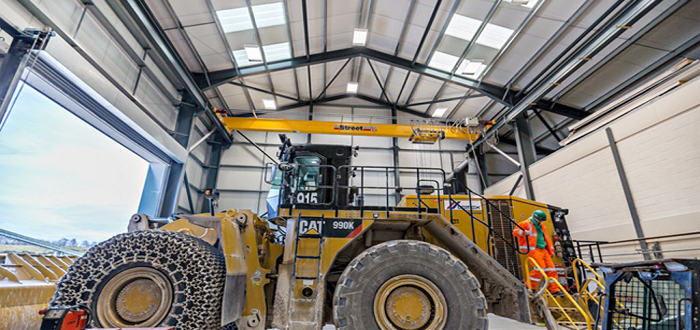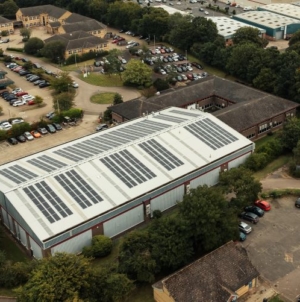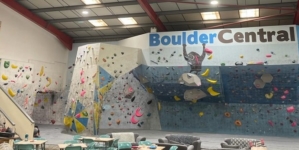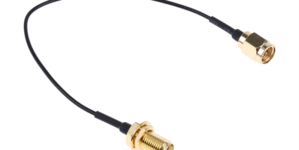-
Sparck Technologies awarded Royal designation - March 27, 2025
-
OpenADR Alliance announces first OpenADR 3.0 certified products with EVoke Systems, E.ON Energy and Universal Devices - March 25, 2025
-
Growing fulfilment and contract packer appoints new Managing Director - March 25, 2025
-
When is it time to invest in a WMS? Understanding the key trigger points - March 25, 2025
-
eCapital helps Vantage Recruitment on its journey to financial success - March 24, 2025
-
Hugo Beck Celebrates 70 Years of Packaging Innovation with Open House Events - March 20, 2025
-
PROLOG FULFILMENT SUPPORTS LUNA DAILY’S COMMITMENT TO BETTER BODY CARE FOR ALL WOMEN - March 19, 2025
-
Motion Ventures launches largest-ever maritime tech fund at $100M to meet the industry’s new pace of adoption - March 18, 2025
-
ITD GLOBAL APPOINTS GROUP CHIEF REVENUE OFFICER - March 17, 2025
-
SURECAM TEAMS UP WITH ENTERPRISE FLEX-E-RENT FOR VEHICLE REPAIR & MAINTENANCE CONFERENCE - March 14, 2025
Dextra Lighting’s LED solutions cut electricity bills by up to 74% at Cemex.
Building a sustainable future – The case for LED lighting for the industrial sector. In 2016, the Department for Business, Energy and Industrial Strategy reported that the industrial sector accounts for approximately 17% of the UK’s total energy consumption. The figure has halved since the 1980s, ranking it below both domestic users and the service sector. At first sight, this may simply appear as an encouragingly positive development towards a low carbon economy. However, this downward trend conceals the challenges faced by companies today, as energy prices are at an all time high and still rising, whilst eco-legislation is becoming ever more stringent. The decrease in energy is also owed to the fact that economic share of the industrial sector has significantly reduced since the 1970s as the UK shifted to a predominantly tertiary economy.
The reality is that although the technological advancements and new processes of the last 50 years have allowed industry to be more energy-efficient, companies are now ever more reliant on electricity and gas than other fuels for power. By 2014, electricity and gas combined, amounted to 67% of industrial energy, compared to 13% in 1970 and 56% in 1990, and with wholesale prices of electricity and gas on a constant rise for decades, companies have continued to struggle to keep their overheads low and maintain stable profit margins. Between 2004 and 2016, prices for non-domestic consumers have roughly doubled for very small consumers and tripled for larger entities. Add carbon reduction premiums such as the Climate Change Levy (CCL) to the equation, and the costs just keep piling up.
With electricity playing a larger role in powering industrial operations, companies have been investing in energy-efficient technology such as LED lighting and sensor controls, to minimise their energy costs and carbon emissions. Although at first, the initial cost of purchasing LED lighting appeared restrictive, soon its long-life, low-maintenance and energy-saving properties spoke for themselves, making LED the most financially and environmentally sustainable lighting solution available for industrial applications. Due to the intensive nature of such environments, LED technology had to evolve to meet the performance demands of this sector, which is why early on, customers were yet to be convinced of LED’s effectiveness. Soon however, LED products rapidly began to match, and eventually outperform HID or fluorescent equivalents, as persistent technological developments led to the broadening of LED’s functionality and a notable increase in reliability. LED luminaires now offer the same if not improved performance of HID or fluorescent equivalents whilst consuming in the region of 70% less energy with the added advantage of eliminating the maintenance costs of frequent lamp replacements. With the addition of sensor controls, this figure can also be raised substantially. LED therefore, fits perfectly into the industrial model, which is to be as cost-effective, efficient and as eco-friendly as possible.
ABOUT THE CLIENT
Founded in 1906, CEMEX has grown to become a global player in the cement and aggregates industry with a multi-billion dollar turnover and 40,000 employees worldwide. During its 80-year history in the UK, the company has established itself as market-leader in ready mixed concrete and has become a leading supplier of mortars and screeds; building a strong reputation for reliability and outstanding technical expertise. With over 230 plants and a vast logistic network, CEMEX now supplies high-quality materials to every corner of the UK.
With growth, however, comes responsibility, as CEMEX is under the scrutiny of its international stakeholders to maximise profit whilst mitigating its environmental and social impact. Sustainable development is therefore at the core of the company’s corporate ethos, with efficiency measures permeating every aspect of operations. To help address these responsibilities, CEMEX decided to convert to LED in selected sites starting from its quarries and workshops in Pentre Halkyn, North Wales, choosing Dextra Lighting as the sole lighting manufacturer for the project.
The partnership began not only due to Dextra Group’s wide range of high-quality products specifically designed for industrial applications, unrivalled delivery times in the UK, vast bespoke manufacturing capabilities, and a highly experienced in-house design and specification team, but as a result of sharing core values and approaches to business. For global companies such as CEMEX it is important to ensure that social responsibility remains a priority and environmental policies in line with ISO 14001 environmental management criteria and other internationally recognised standards are upheld not only within its immediate operations, but throughout its supply chain.
THE BRIEF
Classified as a “Large non-domestic energy consumer”, CEMEX’s plant has been on the receiving end of a significant energy price hike since taking over the quarry in 2006. With the addition of a new state-of-the-art processing plant and workshop, energy costs have inevitably increased further. Between 2004 and 2016 prices have surged from 3.22 to 9.66 pence per K/Wh (inc. CCL) for businesses of this size and still rising. Therefore, cuts to electricity consumption would result in a substantial difference to the company’s operational efficiency. Following a detailed energy report on the site’s existing installation conducted by Dextra Lighting, a selection of high-performance LED luminaires were handpicked to substantially improve energy-efficiency in areas including outdoor quarrying sites, electrical workshops, stores, WC facilities, offices, corridors and canteen facilities.
In addition to the energy-savings generated by precision-engineered LED luminaires, the lowered carbon emissions will also improve the company’s performance in the Carbon Reduction Commitment league table, leading to further financial savings. The products selected from Dextra Lighting’s LED were to comply to all safety and performance standards for industrial applications and meet the energy-saving criteria set by the Energy Technology List (ETL), making CEMEX eligible to the government’s Enhanced Capital Allowance (ECA) scheme, offering 100% tax relief within the first year of purchase.
“Dextra Lighting’s LED lighting solution consumes 74% less energy than the previous T8 fluorescent fixtures in the main building and a 56% reduction from the HQI fittings in the new workshop”
THE PRODUCTS
Tracer LED Lowbay – New Quarry Workshop
The Tracer LED allowed CEMEX to improve the lighting conditions of its new workshop whilst making substantial savings on energy, maintenance and even installations costs. Available in three different outputs, the luminaire is specifically designed to be an effective replacement for HID or fluorescent high-level fittings. For the workshop, a 25,650llm, version replaced the existing 400w HQI (Osram’s trademark Hydrogyrum Quartz Iodide – a type of metal halide lamp) fittings on a one-for-one basis without modifying external wiring. The workshop is now lit by the same amount of luminaires but consumes 56% less energy than the previous fixtures thanks to the Tracer’s high-efficiency optical design and the latest 3535 Lumileds LEDs. Each ECA compliant luminaire now performs at an impressive efficiency of 131 luminaire-lumens-per-watt. Unlike the previous HID sources, these durable sources do not suffer from rapid lumen depreciation and do not need frequent replacing – saving CEMEX the cost and disruption of regular maintenance in inconvenient high-level areas.
Further savings were made as a result of the Tracer LED’s low-weight and attractive slimline construction, making it easier to handle for a quicker and more efficient installation while its optional integral emergency control gear eliminated the need to install standalone emergency solutions across the workshop.
To maximise energy savings and offer additional lighting control, the luminaire is available in either Analogue 1 – 10v or DALI dimming functions to offer compatibility with a range of standalone sensor from Dextra’s Reacta range for daylight regulation and presence detection.
Hydra LED – Electrical Workshop / Stores / WC Facilities / First-aid room
The Hydra LED is purpose-built to offer the premium performance, maximum durability and minimum maintenance required for demanding industrial environments. The luminaire’s IP65-rated glass reinforced housing, steel gear tray and sturdy polycarbonate diffuser combine to offer protection to water, dirt and dust ingress and light impact and is suitable for use in areas where the temperature ranges from -20°C to +25°C*. Combined with the longevity and rugged durability of its Lumileds LED source, its robust body is ideal for hard to access areas where the cost of maintaining conventional HID/fluorescent fittings is high. Stainless steel diffuser clips and tamper-resistant screws were supplied as standard to ensure tooled access in compliance with regulations.
The Hydra LED was selected for the electrical workshops not only for its tough construction and low-maintenance qualities but primarily for its high-performance specifications. By combining the latest Lumileds LEDs with its high-efficiency clear diffuser, the luminaire offers light output ratios of over 90% whilst performing at an average of 140 Llm/w. Both 3276llm, 5956llm and 8982llm versions were used to provide the desired lux levels and uniformity ratios in different areas of the workshops, the stores, WC facilities and first-aid room, depending on ceiling height, room size and task illuminance requirements. Not only did these luminaries have an electrical load over 70% lower than the previous 70w fluorescent battens, but fewer fittings were required to reach the same light levels, reducing the total cost of ownership for CEMEX.
The versatile luminaire is available in output packages of between 2046llm and 18,630llm, in three different lengths in either twin or single bodies, allowing lighting schemes to be designed to suit the specific demands of different retrofit or new-build applications. The luminaire is also offered with a wide range of dimming functions and sensor compatibility to create tailor-made intelligent lighting solutions for maximum energy savings.
*Temperature ranges for emergency will vary
MODLED Slim – Offices, Corridors & Canteen
From a wide range of lumen outputs (from 1250llm to as high as 12,160llm) and sizes, the versatile MODLED Slim recessed luminaire was installed in a standard 600 x 600mm body with a 2280llm output in both the canteen, offices and neighbouring corridors. This output offers BSEN 12464 compliant glare control making it ideal for use in areas where computer are in use. If required, higher outputs that meet the 3000 candela per square metre and UGR 19 glare limitations for offices and schools are also available. LORs as high as 85% for clarity and brightness can therefore be obtained with each installation without compromising on visual comfort.
In addition to providing a superior light quality, the MODLED Slim is currently the most efficient office lighting solution in Dextra Lighting’s range. With a power load from as low as 18.9w, it allows fully compliant lighting schemes to be designed with the minimum number of luminaires for an improved return on investment. Its high-quality LED source and high-transmission panel luminaire offer LORs of 85% and an efficiency of up to 136Llm/w depending on output.
Overall, the MODLED Slim reduced the total electrical load in each area by up to 78% compared to the previous T8 fluorescent system; using fewer luminaires to achieve the same or higher lux levels. On top of these energy savings, the new LED system improved general light quality and slashed maintenance costs; vastly improving returns on investment for CEMEX in the long-term.
The MODLED Slim can be customised with a wide range of four dimming functions compatible with multiple sensor options (integral or standalone) to offer intelligent energy-saving lighting control. The luminaire is also available in both lay-in and pull-up installation formats to suit different ceiling types.
OPUS 2 LED – Outdoor Lighting
Throughout last year, Dextra Lighting has been replacing the older HID fittings at CEMEX’s Pentre Halkyn quarrying site with versions of the OPUS LED floodlight. Its selection of four housing sizes (small to extra-large) and output packages ranging from 2700llm to 25,533llm, were put to full use to provide the light levels, uniformity and distribution required for different outdoor areas.
The OPUS 2 LED is designed with durability in mind. Its die-cast aluminium housing and toughened glass covers offer fully-gasketed IP65 protection, making it the ideal choice for the quarrying and mining sites, as well as the car parks and other external areas.
On a performance level, the OPUS 2 is manufactured using the latest Philips or Tridonic LEDs and drivers to offer high standards of energy-efficiency with minimal maintenance to reduce overall lifetime cost of ownership. Combined with efficient high-grade aluminium reflectors, the luminaire can therefore offer LORs in excess of 85% and perform at an efficiency of as high as 106 Llm/w.
The higher output variants (9037llm to 25,533llm) also offer a Constant Lumen Output function which gradually increase power over time to ensure there is no lumen depreciation in the first 50,000 hours of operation; allowing the installation to perform as intended from the moment of purchase. Medium to Extra-Large versions can also be customised with an asymmetrical reflector to suit the application. Digital and analogue dimming functions are also available with this range to offer additional energy savings (when paired with standalone photocell or presence detection sensors) and accurate lighting control.
Emergency
All the products featured in this project are available with a number of emergency options. In this case, they were installed with integral 3-hour Self-Test emergency functions, saving CEMEX the extra costs of installing standalone emergency fixtures across the building. The Self-Test option offers periodic function and duration tests in accordance with EN 62034:2012 requirements, featuring an LED indicator to signal the status of the luminaire’s emergency driver. Auto-test functions are also available with most of Dextra Lighting’s LED products, allowing users to monitor the status of a centralised network of luminaires via a user-friendly digital interface.
THE RESULTS
Energy reports show that Dextra Lighting’s LED lighting solution consumes a total of 74% less energy than the previous T8 fluorescent fixtures in the main building and a 56% reduction from the HQI fittings in the new workshop. Overall this is the equivalent of 10,532 kg of CO2 emissions and a cut of £1899 per annum to the company’s utility bill. These calculations do not include the savings CEMEX will make by eliminating the regular maintenance routines common to fluorescent and HID systems. Furthermore, Dextra Group’s in-house design team ensured that running costs and the total the cost of ownership were kept to a minimum by using fewer luminaries to achieve the same or better lighting results.
The success of this project demonstrates the impact a well-designed LED lighting upgrade can have in an industrial context. CEMEX in this case, can look forward to a fast payback period for its new system and once the system is paid off, the resulting savings will continue to improve the company’s profit margins for years to come whilst fulfilling its commitment to the environment. Impressed with the results, CEMEX will meet with Dextra Lighting once again discuss applying the same sustainable approach to lighting in other sites across the UK.
https://www.dextragroup.co.uk/dextra-lighting/projects/dextra-lightings-led-solutions-cut-cemexs-electricity-bills-by-up-to-74/
































